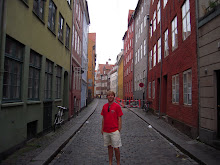
To Guido’s credit, he is incredibly self-cognizant and honest about his failure, for inability to bury the past is exactly what we have witnessed over the course of the film—both Fellini’s film, which we are watching, and Guido’s film, which we are watching the production of—and what continues to occur until the joint conclusion. We watch as Guido’s neglects what he is “supposed” to be doing to get his film made and lets his mind wander to past memories and fantasies. Two primary instances of this departure into Guido’s mind, the Saraghina episode and the Harem fantasy, coupled with the self-reflexive, immediate assessments made by the film critic, can encapsulate the nature of the larger film itself and the thesis Fellini forwards about the process of filmmaking.
The Saraghina and subsequent public shaming recollection comes about when Guido first talks with the Cardinal and other members of the Catholic Church, discussing the possibility of appearing in his film. Guido discusses how the protagonist has “certain needs he can no longer process” and believes that a prince of the church would be a “depositary of truth” and could provide a “flash of understanding.” (On a side note: the idea of a filmmaker making a film primarily for himself rarely pertains as much as it does here, both for Guido and Fellini). So Guido meets with the Cardinal, after being admonished about mixing “sacred and profane love too casually” and being reminded that he has the power to “educate and corrupt”.
Becoming quickly bored with the Diomedeo bird that captivates the Cardinal, Guido sees a larger woman who reminds him of a lustful character of his past, and his mind immediately wanders. Guido does his trademark glasses-push-to-the-bridge-of-his-nose, signifying a lapse of the present reality, and we return to his school days, when Guido is being pressured by a chanting group of friends to go see the “Saraghina”, a woman who erotically dances for money on the beach. In an incredible high shot, we see a mid-decision Guido, framed in between the head and arm of religious statue in an ethical and righteous pose.

Guido is visually within the confines of the Catholic “rules”, but then he runs out, and, as such, the camera follows him to the right as he runs to quell his naughty wishes. After being caught at the beach, Guido is hoisted back to receive his Catholic punishment from a committee of stern religious figures. His mother watches and waits, sitting by a portrait of Guido, the sad reminder that he could’ve been a pure boy, that he was next in line and ready to join the ranks of the other religious leaders whose portraits adorned the hallway. Immediately after the daydream, Guido is talking with the film critic, who represents the nagging self-critical voice of Guido, and he questions the meaning and purpose of these flashbacks. He attacks Guido’s work, saying he needs a “higher degree of culture” as well as more “clarity and logic” to make it successful. Guido’s naivete is “a serious failing”.
This progression—from Guido in reality to his daydream to the critic’s assessment—is copied later when Guido fantasizes about his own Harem. While sitting with wife Luisa and dealing with her and Rosella’s disparaging comments about Guido’s recently arrived mistress Carla, Guido escapes this domestic nightmare by imagining the two talking honestly and then dancing together. This transitions into the elaborate Harem scene, involving all of the women Guido has ever had sexual thoughts about. Here, Guido is his own sort of Cardinal: he determines whether or not his first sexual fantasy should go “upstairs” or not. Guido does end up mixing the sacred and profane love casually, directly correlating the Catholic Church and who decides goes up to heaven to his erotic dancer who should go upstairs. After telling his table of women that, “happiness is being able to tell the truth without ever making anybody suffer” (yet another layer of self-reflexivity Fellini adds to the process of filmmaking), and watching Luisa accept and cope with his existence, the daydream ends. Immediately after, the hovering critic analyzes the work: “you called to solve a problem for which there is no solution.” Guido promptly imagines bodyguards hanging the critic.

The simple brilliance of the narrative, for which these two dream departures are pillars, is that, as we watch Guido fail to make his film, we realize Fellini has succeeded at his own. He has woven together those elements of the past that were condemned at not having meaning, with the present mission of Guido’s which is the same as Fellini’s, and has succeeded at creating a meaningful work about creating meaningful work. That’s not to say that there isn’t a sense of criticism about the filmmaking process here, because that’s essential to the meaning Fellini creates. This outlook climaxes with the critic’s final, extensive two and a half minute conclusion. The critic ends, saying: “And how do you benefit from stringing together the tattered pieces of your life? Your vague memories, the faces of people that you were never able to love…”
Guido’s response, to strip down its beautiful layers to the core, is, as he tells Luisa: “Life is a celebration. Let’s live it together.” Don’t bury the past or the memories. All art is personal, an extension of the self. Don’t suppress the urge to communicate, to tell, to relive. Instead, create.


